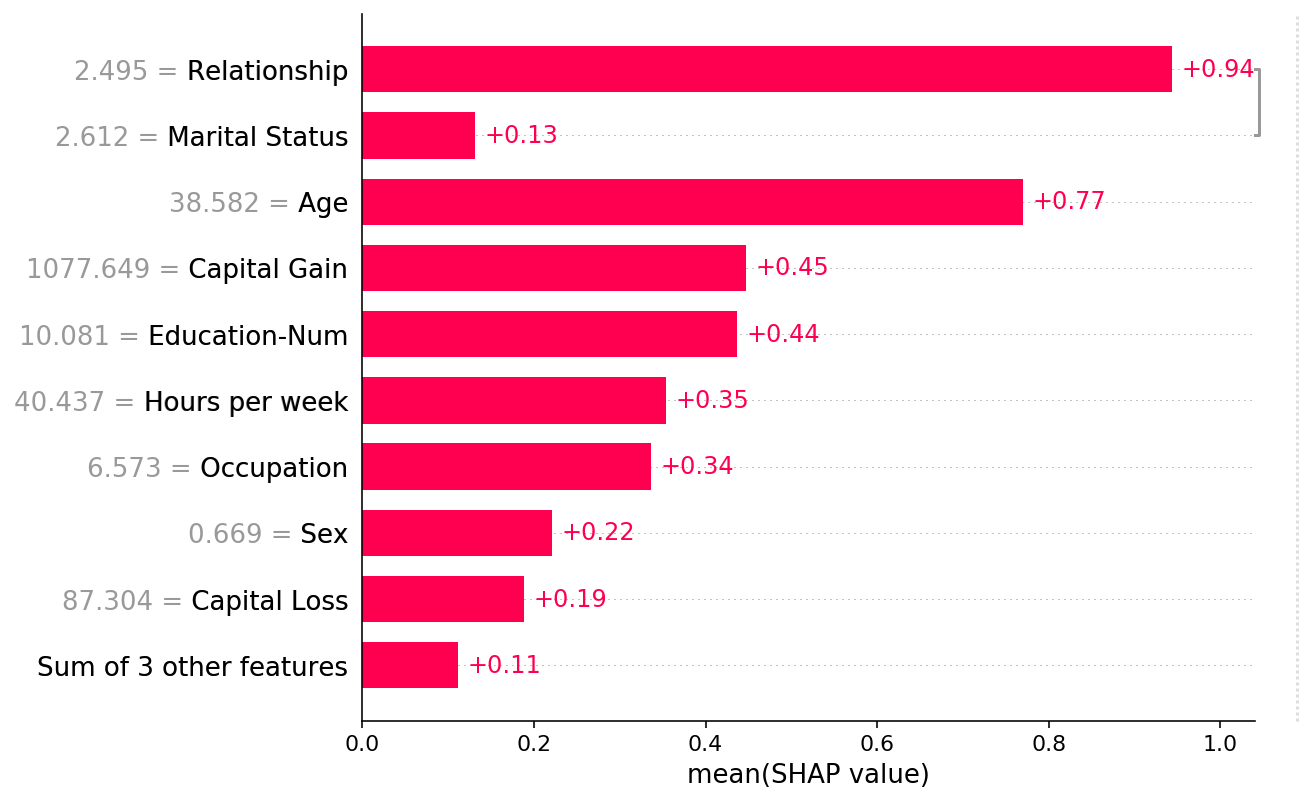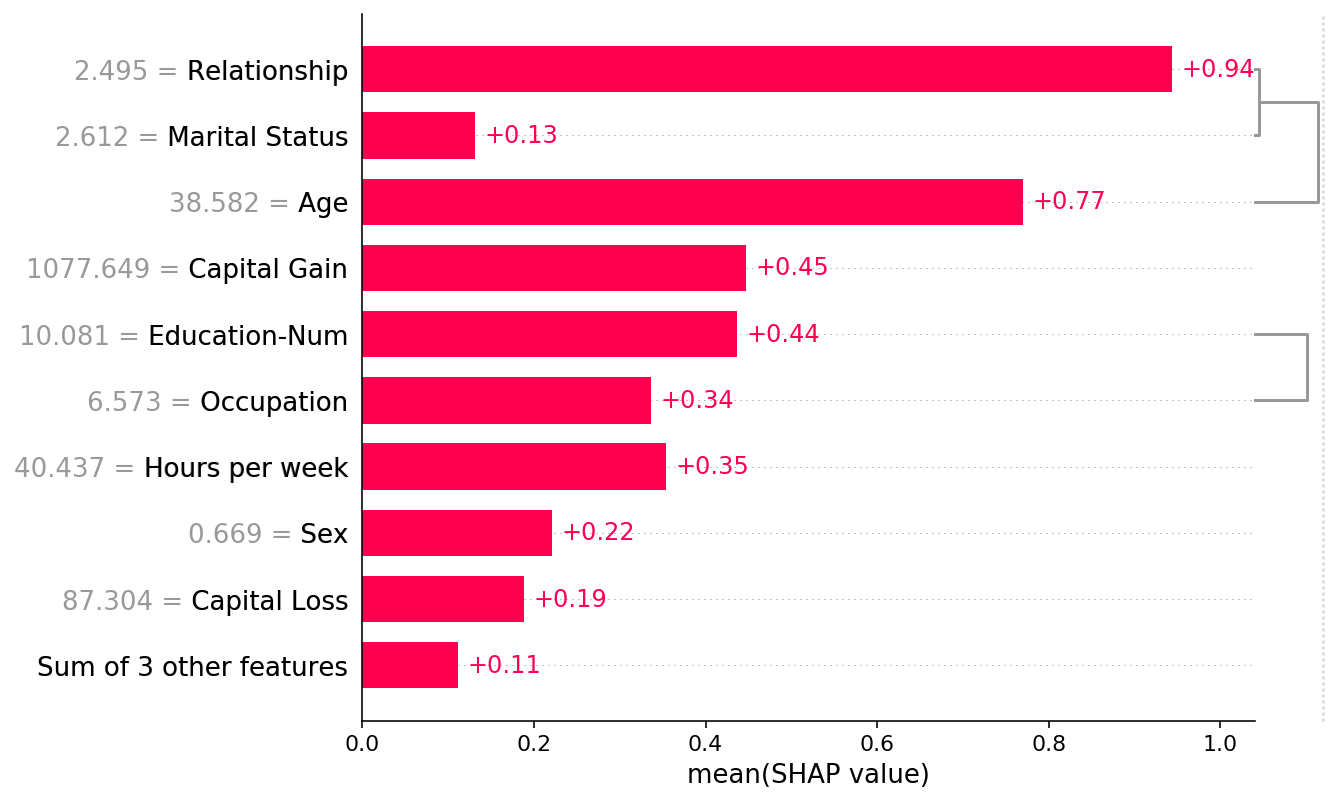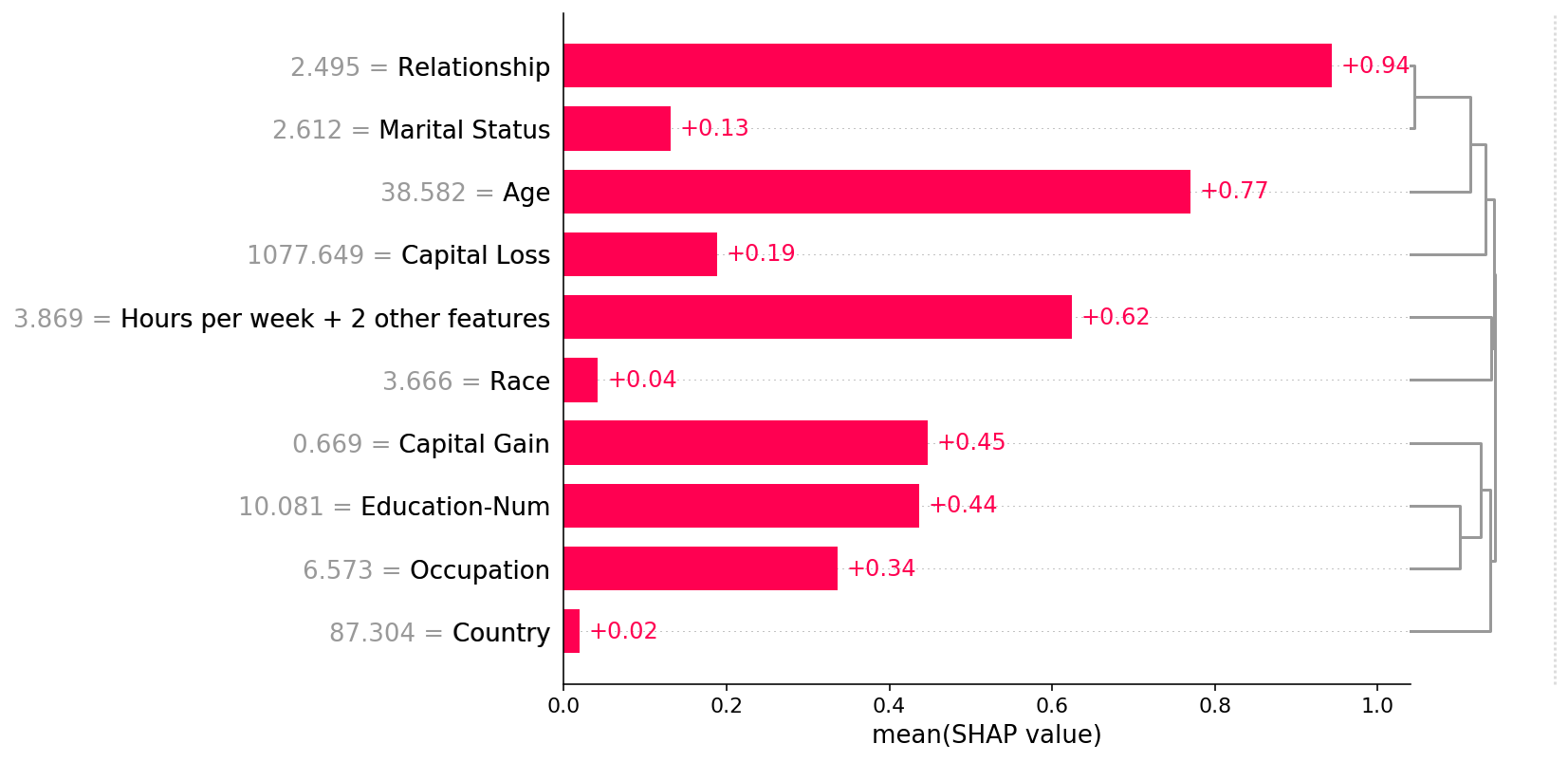Explainable AI with Shapley values¶
This is an introduction to explaining machine learning models with Shapley values. Shapley values are a widely used approach from cooperative game theory that come with desirable properties. This tutorial is designed to help build a solid understanding of how to compute and interpet Shapley-based explanations of machine learning models. We will take a practical hands-on approach, using the shap Python package to explain progressively more complex models. This is a living document, and the
serves as an introduction to the shap Python package. So if you have feedback or contributions please open an issue or pull request to make this tutorial better!
Note this document depends on a new API for SHAP that may change slightly in the coming weeks.
Outline
Explaining a linear regression model
Explaining a generalized additive regression model
Explaining a gradient boosted decision tree regression model
Explaining a logistic regression model
Explaining a XGBoost logistic regression model
Dealing with correlated input features
Explaining a transformers NLP model
Explaining a linear regression model¶
Before using Shapley values to explain complicated models, it is helpful to understand how they work for simple models. One of the simplest model types is standard linear regression, and so below we train a linear regression model on the classic boston housing dataset. This dataset consists of 506 neighboorhood regions around Boston in 1978, where our goal is to predict the median home price (in thousands) in each neighboorhood from 14 different features:
CRIM - per capita crime rate by town
ZN - proportion of residential land zoned for lots over 25,000 sq.ft.
INDUS - proportion of non-retail business acres per town.
CHAS - Charles River dummy variable (1 if tract bounds river; 0 otherwise)
NOX - nitric oxides concentration (parts per 10 million)
RM - average number of rooms per dwelling
AGE - proportion of owner-occupied units built prior to 1940
DIS - weighted distances to five Boston employment centres
RAD - index of accessibility to radial highways
TAX - full-value property-tax rate per $10,000
PTRATIO - pupil-teacher ratio by town
B - 1000(Bk - 0.63)^2 where Bk is the proportion of blacks by town
LSTAT - % lower status of the population
MEDV - Median value of owner-occupied homes in $1000’s
[92]:
import pandas as pd
[1]:
import shap
import sklearn
# a classic housing price dataset
X,y = shap.datasets.boston()
X100 = shap.utils.sample(X, 100)
# a simple linear model
model = sklearn.linear_model.LinearRegression()
model.fit(X, y)
[1]:
LinearRegression()
[1]:
import shap
import sklearn
# a classic housing price dataset
X,y = shap.datasets.boston()
X100 = shap.utils.sample(X, 100)
# a simple linear model
model = sklearn.linear_model.LinearRegression()
model.fit(X, y)
[1]:
LinearRegression()
Examining the model coefficients¶
The most common way of understanding a linear model is to examine the coefficients learned for each feature. These coefficients tell us how much the model output changes when we change each of the input features:
[2]:
print("Model coefficients:\n")
for i in range(X.shape[1]):
print(X.columns[i], "=", model.coef_[i].round(4))
Model coefficients:
CRIM = -0.108
ZN = 0.0464
INDUS = 0.0206
CHAS = 2.6867
NOX = -17.7666
RM = 3.8099
AGE = 0.0007
DIS = -1.4756
RAD = 0.306
TAX = -0.0123
PTRATIO = -0.9527
B = 0.0093
LSTAT = -0.5248
While coefficents are great for telling us what will happen when we change the value of an input feature, by themselves they are not a great way to measure the overall importance of a feature. This is because the value of each coeffient depends on the scale of the input features. If for example we were to measure the age of a home in minutes instead of years, then the coeffiect for the AGE feature would become \(0.0007 * 365 * 24 * 60 = 367.92\). Clearly the number of minutes since a house was built is not more important than the number of years, yet it’s coeffiecent value is much larger. This means that the magnitude of a coeffient is not nessecarily a good measure of a feature’s importance in a linear model.
A more complete picture using partial dependence plots¶
To understand a feature’s importance in a model it is necessary to understand both how changing that feature impacts the model’s output, and also the distribution of that feature’s values. To visualize this for a linear model we can build a classical partial dependence plot and show the distribution of feature values as a histogram on the x-axis:
[3]:
shap.plots.partial_dependence("RM", model.predict, X100, ice=False, model_expected_value=True, feature_expected_value=True)
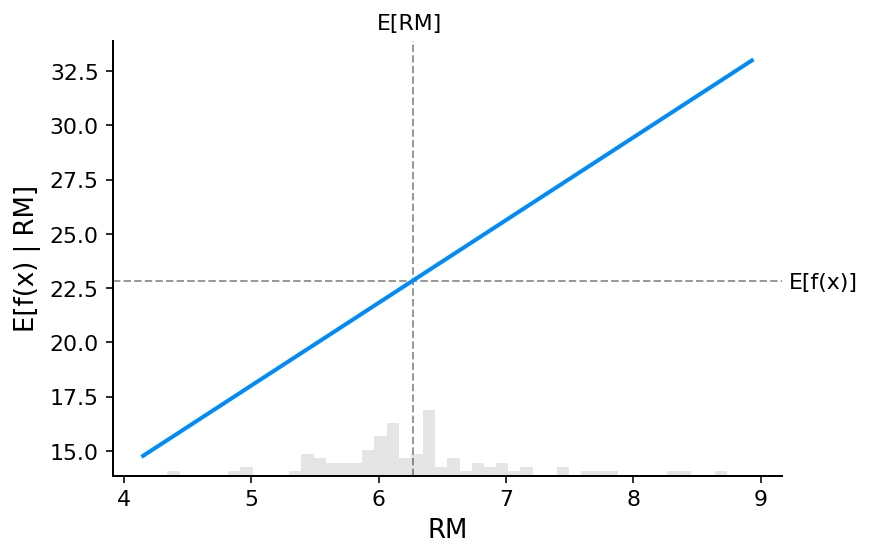
The gray horizontal line in the plot above represents the expected value of the model when applied to the boston housing dataset. The vertical gray line represents the average value of the AGE feature. Note that the blue partial dependence plot line (which the is average value of the model output when we fix the AGE feature to a given value) always passes through the interesection of the two gray expected value lines. We can consider this intersection point as the “center” of the partial dependence plot with respect to the data distribution. The impact of this centering will become clear when we turn to Shapley values next.
Reading SHAP values from partial dependence plots¶
The core idea behind Shapley value based explanations of machine learning models is to use fair allocation results from cooperative game theory to allocate credit for a model’s output \(f(x)\) among its input features . In order to connect game theory with machine learning models it is nessecary to both match a model’s input features with players in a game, and also match the model function with the rules of the game. Since in game theory a player can join or not join a game, we need a way for a feature to “join” or “not join” a model. The most common way to define what it means for a feature to “join” a model is to say that feature has “joined a model” when we know the value of that feature, and it has not joined a model when we don’t know the value of that feature. To evaluate an existing model \(f\) when only a subset \(S\) of features are part of the model we integrate out the other features using a conditional expectated value formulation. This formulation can take two forms:
or
In the first form we know the values of the features in S because we observe them. In the second form we know the values of the features in S because we set them. In general, the second form is usually preferable, both becuase it tells us how the model would behave if we were to intervene and change its inputs, and also because it is much easier to compute. In this tutorial we will focus entirely on the the second formulation. We will also use the more specific term SHAP values to refer to Shapley values applied to a conditional expectation function of a machine learning model.
SHAP values can be very complicated to compute (they are NP-hard in general), but linear models are so simple that we can read the SHAP values right off a partial dependence plot. When we are explaining a prediction \(f(x)\), the SHAP value for a specific feature \(i\) is just the difference between the expected model output and the partial dependence plot at the feature’s value \(x_i\):
[4]:
# compute the SHAP values for the linear model
background = shap.maskers.Independent(X, max_samples=1000)
explainer = shap.Explainer(model.predict, background)
shap_values = explainer(X)
# make a standard partial dependence plot
sample_ind = 18
fig,ax = shap.partial_dependence_plot(
"RM", model.predict, X, model_expected_value=True,
feature_expected_value=True, show=False, ice=False,
shap_values=shap_values[sample_ind:sample_ind+1,:],
shap_value_features=X.iloc[sample_ind:sample_ind+1,:]
)
Permutation explainer: 507it [00:14, 34.26it/s]
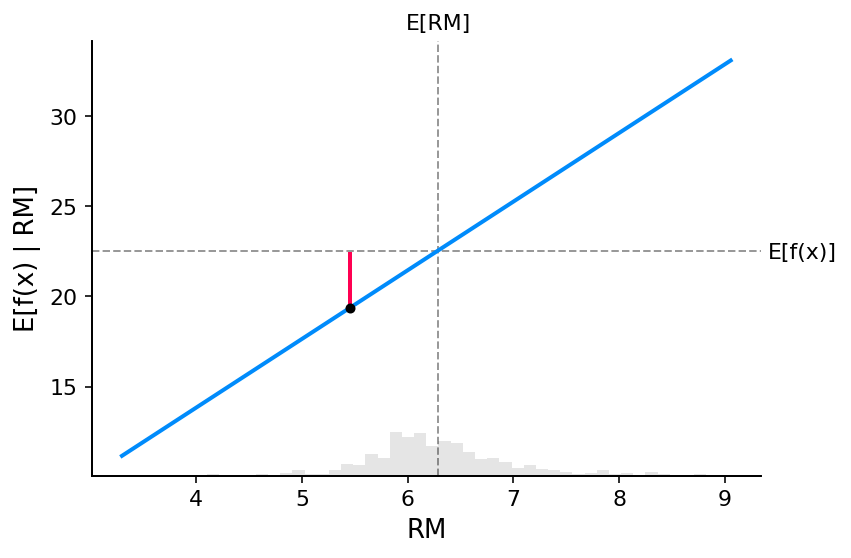
The close correspondence between the classic partial dependence plot and SHAP values means that if we plot the SHAP value for a specific feature across a whole dataset we will exactly trace out a mean centered version of the partial dependence plot for that feature:
[5]:
shap.plots.scatter(shap_values[:,"RM"])
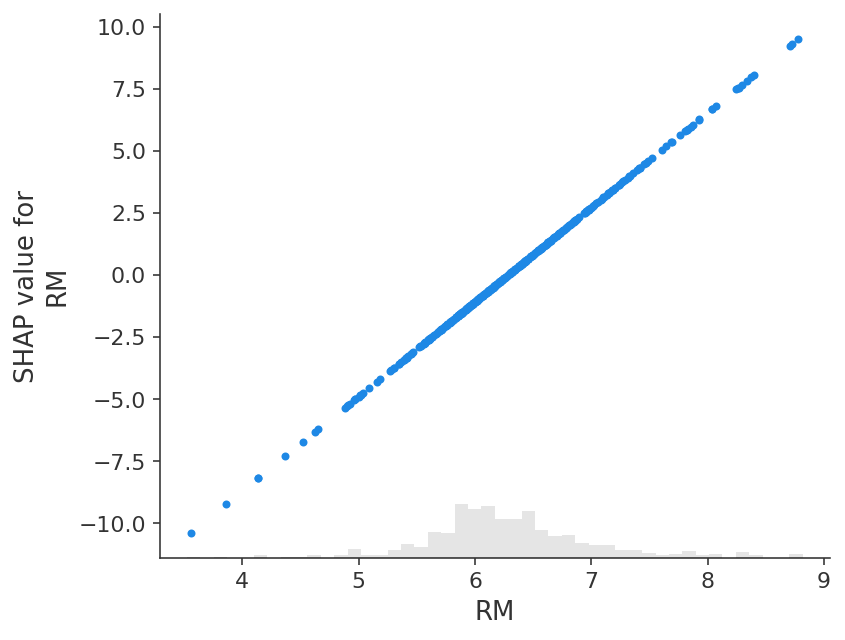
The additive nature of Shapley values¶
One the fundemental properties of Shapley values is that they always sum up to the difference between the game outcome when all players are present and the game outcome when no players are present. For machine learning models this means that SHAP values of all the input features will always sum up to the difference between baseline (expected) model output and the current model output for the prediction being explained. The easiest way to see this is through a waterfall plot that starts our background prior expectation for a home price \(E[f(X)]\), and then adds features one at a time until we reach the current model output \(f(x)\):
[6]:
# the waterfall_plot shows how we get from shap_values.base_values to model.predict(X)[sample_ind]
shap.plots.waterfall(shap_values[sample_ind], max_display=14)
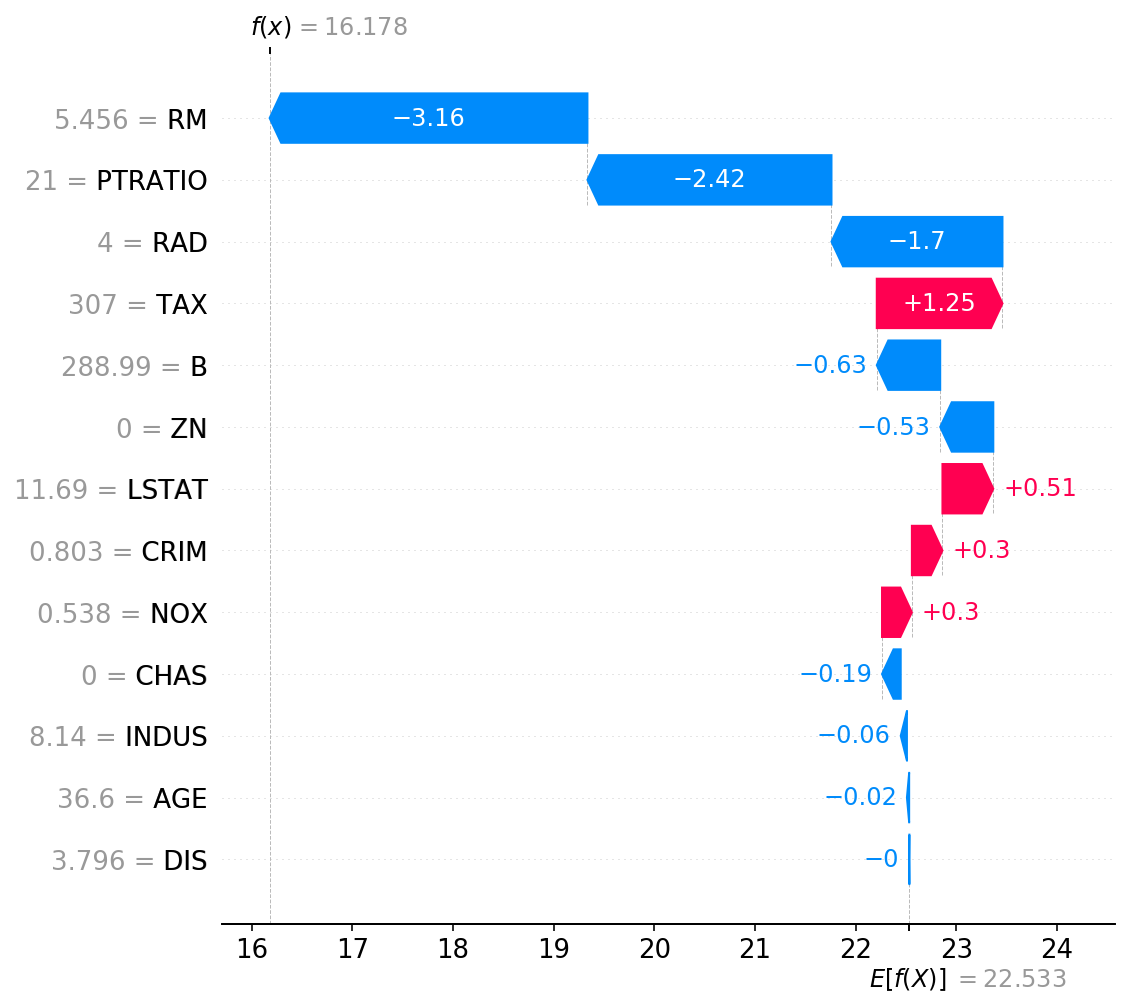
Explaining an additive regression model¶
The reason the partial dependence plots of linear models have such a close connection to SHAP values is because each feature in the model is handled independently of every other feature (the effects are just added together). We can keep this additive nature while relaxing the linear requirement of straight lines. This results in the well-known class of generalized additive models (GAMs). While there are many ways to train these types of models (like setting an XGBoost model to depth-1), we will use InterpretMLs explainable boosting machines that are specifically designed for this.
[7]:
# fit a GAM model to the data
import interpret.glassbox
model_ebm = interpret.glassbox.ExplainableBoostingRegressor()
model_ebm.fit(X, y)
# explain the GAM model with SHAP
explainer_ebm = shap.Explainer(model_ebm.predict, background)
shap_values_ebm = explainer_ebm(X)
# make a standard partial dependence plot with a single SHAP value overlaid
fig,ax = shap.partial_dependence_plot(
"RM", model_ebm.predict, X, model_expected_value=True,
feature_expected_value=True, show=False, ice=False,
shap_values=shap_values_ebm[sample_ind:sample_ind+1,:],
shap_value_features=X.iloc[sample_ind:sample_ind+1,:]
)
Permutation explainer: 507it [00:37, 13.64it/s]
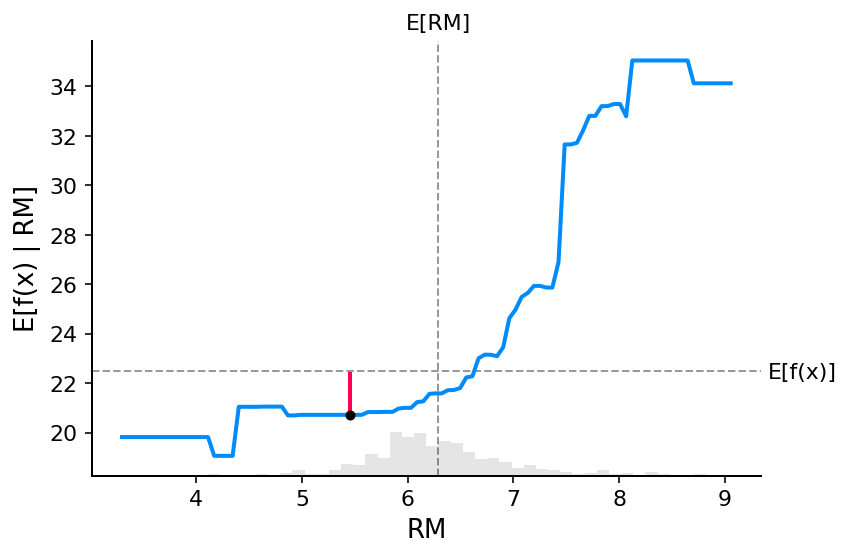
[8]:
shap.plots.scatter(shap_values_ebm[:,"RM"])
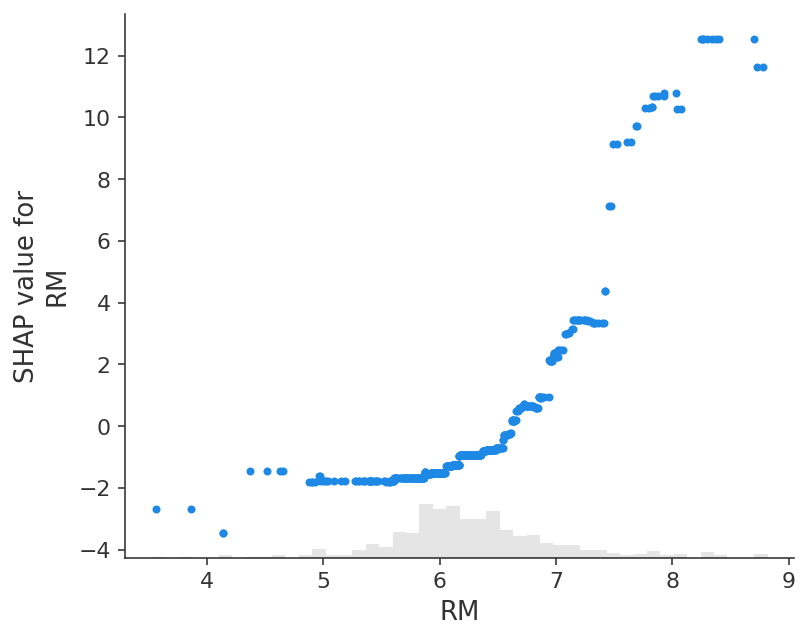
[10]:
# the waterfall_plot shows how we get from explainer.expected_value to model.predict(X)[sample_ind]
shap.plots.waterfall(shap_values_ebm[sample_ind], max_display=14)
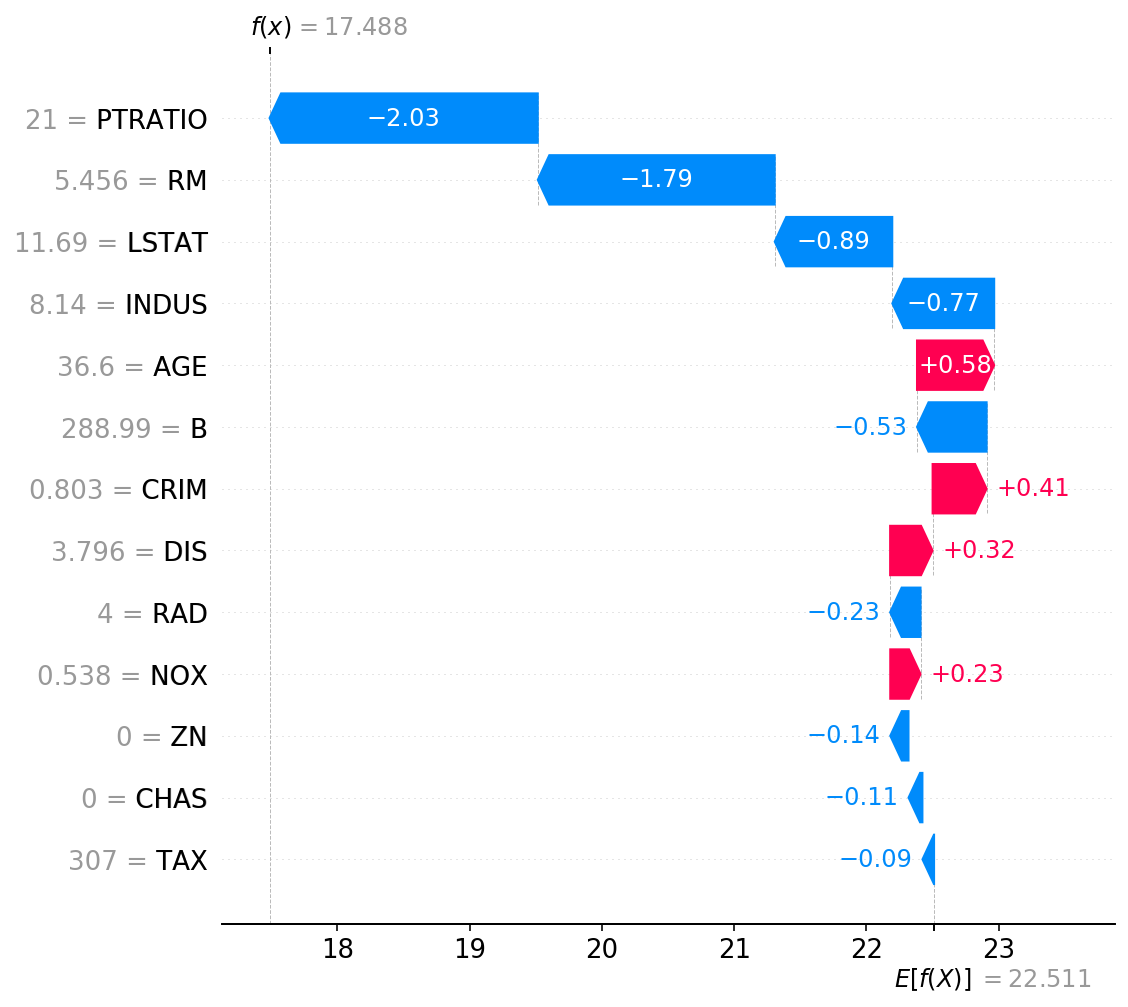
[11]:
# the waterfall_plot shows how we get from explainer.expected_value to model.predict(X)[sample_ind]
shap.plots.beeswarm(shap_values_ebm, max_display=14)
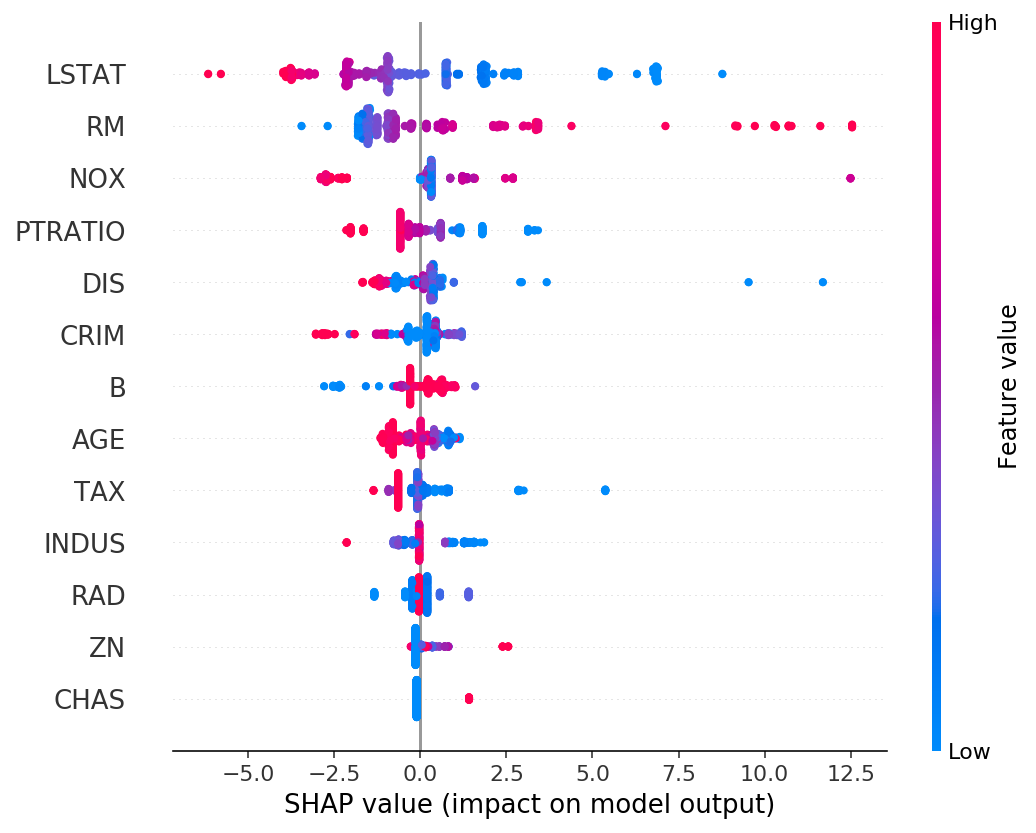
Explaining a non-additive boosted tree model¶
[12]:
# train XGBoost model
import xgboost
model_xgb = xgboost.XGBRegressor(nestimators=100, max_depth=2).fit(X, y)
# explain the GAM model with SHAP
explainer_xgb = shap.Explainer(model_xgb, background)
shap_values_xgb = explainer_xgb(X)
# make a standard partial dependence plot with a single SHAP value overlaid
fig,ax = shap.partial_dependence_plot(
"RM", model_xgb.predict, X, model_expected_value=True,
feature_expected_value=True, show=False, ice=False,
shap_values=shap_values_ebm[sample_ind:sample_ind+1,:],
shap_value_features=X.iloc[sample_ind:sample_ind+1,:]
)
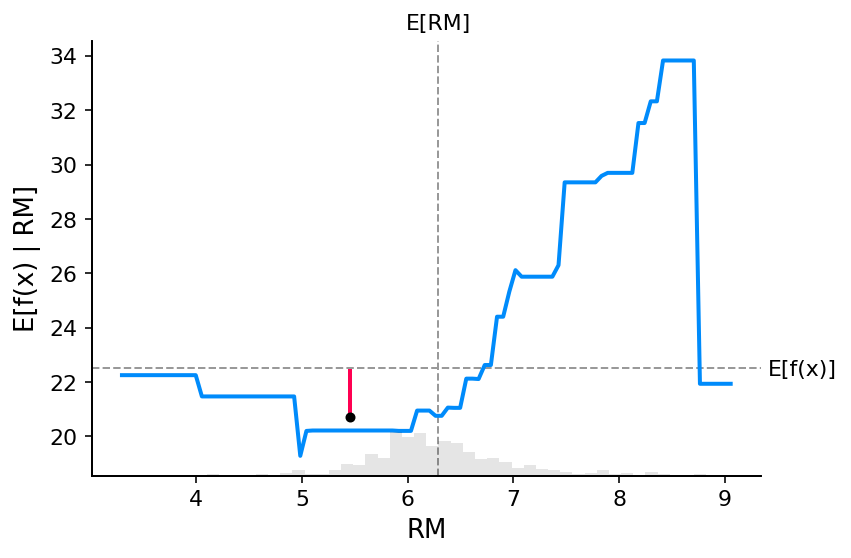
[13]:
shap.plots.scatter(shap_values_xgb[:,"RM"])
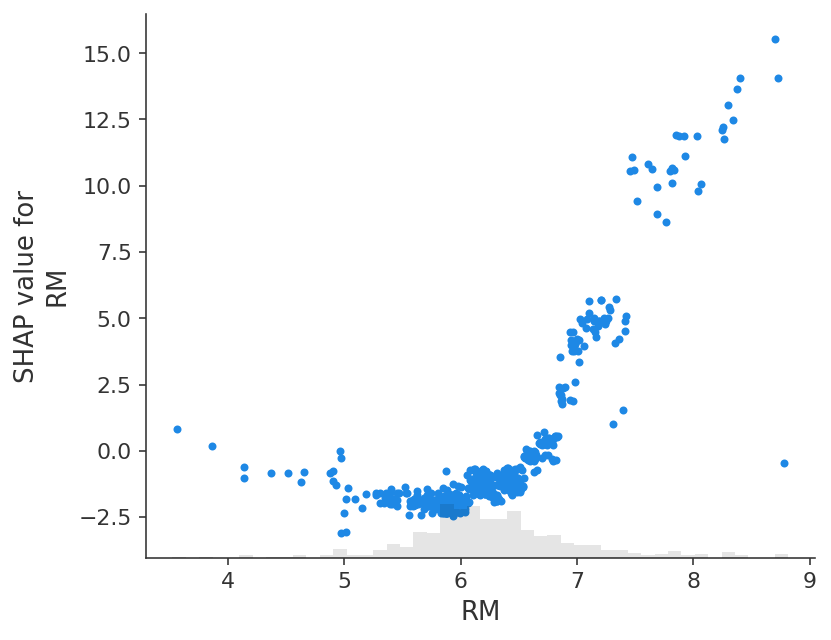
[14]:
shap.plots.scatter(shap_values_xgb[:,"RM"], color=shap_values)
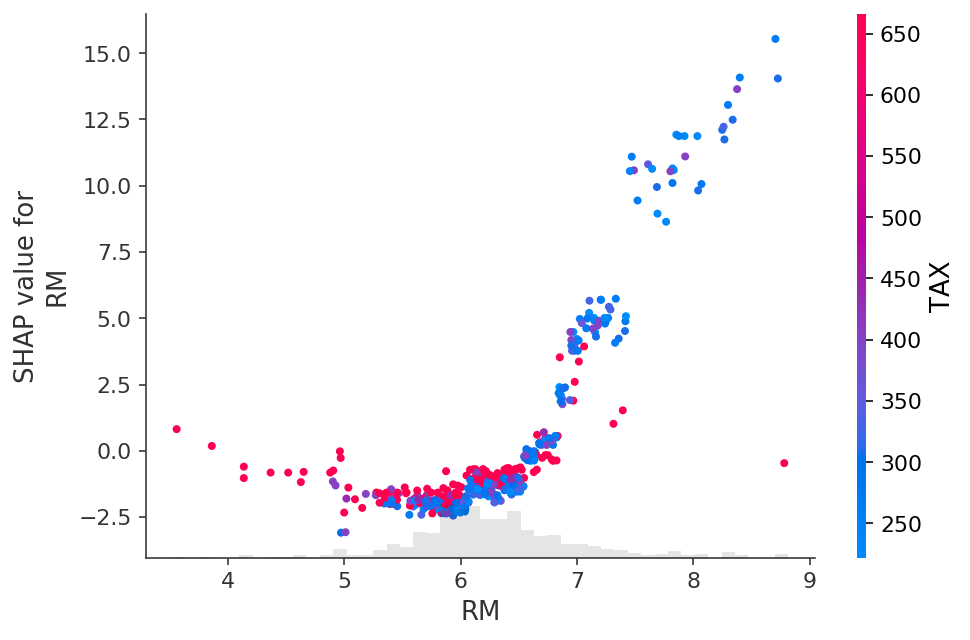
Explaining a linear logistic regression model¶
[15]:
# a classic adult census dataset price dataset
X_adult,y_adult = shap.datasets.adult()
# a simple linear logistic model
model_adult = sklearn.linear_model.LogisticRegression(max_iter=10000)
model_adult.fit(X_adult, y_adult)
def model_adult_proba(x):
return model_adult.predict_proba(x)[:,1]
def model_adult_log_odds(x):
p = model_adult.predict_log_proba(x)
return p[:,1] - p[:,0]
[15]:
LogisticRegression(max_iter=10000)
Note that explaining the probability of a linear logistic regression model is not linear in the inputs.
[51]:
# make a standard partial dependence plot
sample_ind = 18
fig,ax = shap.partial_dependence_plot(
"Capital Gain", model_adult_proba, X_adult, model_expected_value=True,
feature_expected_value=True, show=False, ice=False
)
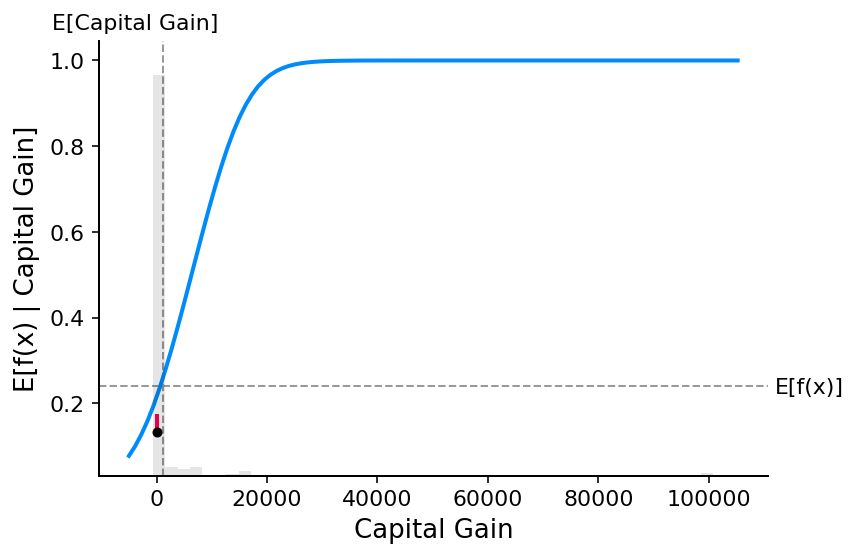
If we use SHAP to explain the probability of a linear logistic regression model we see strong interaction effects. This is because a linear logistic regression model NOT additive in the probability space.
[52]:
# compute the SHAP values for the linear model
background_adult = shap.maskers.Independent(X_adult, max_samples=1000)
explainer = shap.Explainer(model_adult_proba, background_adult)
shap_values_adult = explainer(X_adult[:1000])
Permutation explainer: 1001it [00:32, 30.99it/s]
[41]:
shap.plots.scatter(shap_values_adult[:,"Age"])
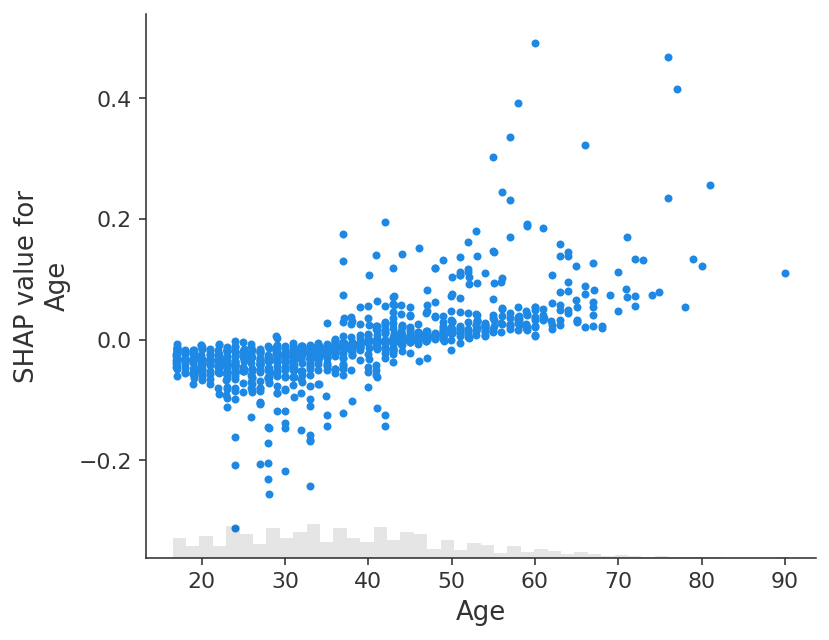
If we instead explain the log-odds output of the model we see a perfect linear relationship between the models inputs and the model’s outputs. It is important to remember what the units are of the model you are explaining, and that explaining different model outputs can lead to very different views of the model’s behavior.
[53]:
# compute the SHAP values for the linear model
explainer_log_odds = shap.Explainer(model_adult_log_odds, background_adult)
shap_values_adult_log_odds = explainer_log_odds(X_adult[:1000])
divide by zero encountered in log
Permutation explainer: 1001it [00:33, 30.02it/s]
[54]:
shap.plots.scatter(shap_values_adult_log_odds[:,"Age"])
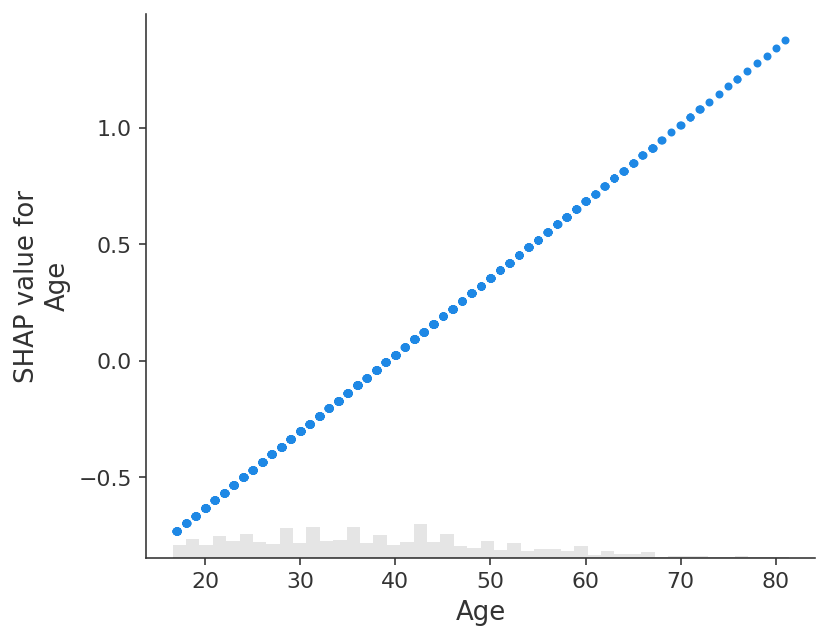
[38]:
# make a standard partial dependence plot
sample_ind = 18
fig,ax = shap.partial_dependence_plot(
"Age", model_adult_log_odds, X_adult, model_expected_value=True,
feature_expected_value=True, show=False, ice=False,
#shap_values=shap_values[sample_ind:sample_ind+1,:],
#shap_value_features=X.iloc[sample_ind:sample_ind+1,:]
)
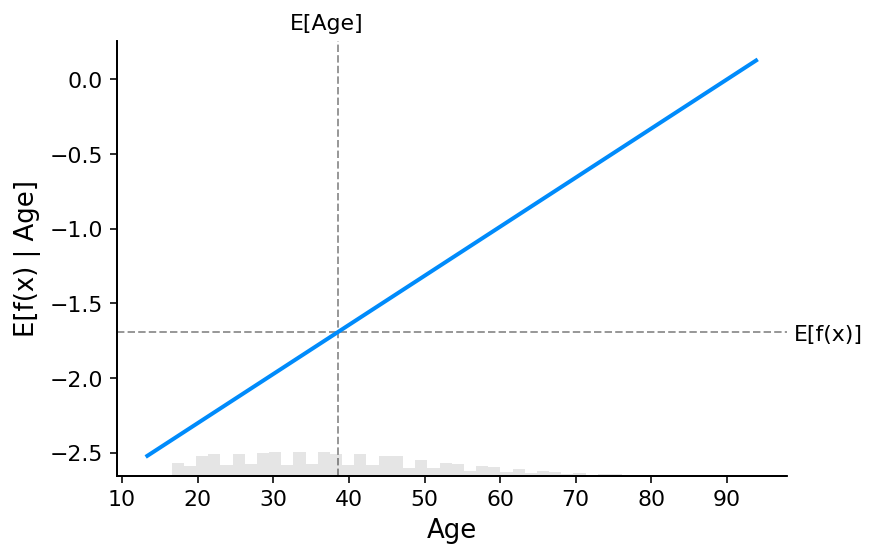
Explaining an XGBoost logistic regression model¶
[56]:
# train XGBoost model
X,y = shap.datasets.adult()
model = xgboost.XGBClassifier(nestimators=100, max_depth=2).fit(X, y)
# compute SHAP values
explainer = shap.Explainer(model, X)
shap_values = explainer(X)
# set a display version of the data to use for plotting (has string values)
shap_values.display_data = shap.datasets.adult(display=True)[0].values
94%|=================== | 30731/32561 [00:11<00:00]
By default a SHAP bar plot will take the mean absolute value of each feature over all the instances (rows) of the dataset.
[60]:
shap.plots.bar(shap_values)
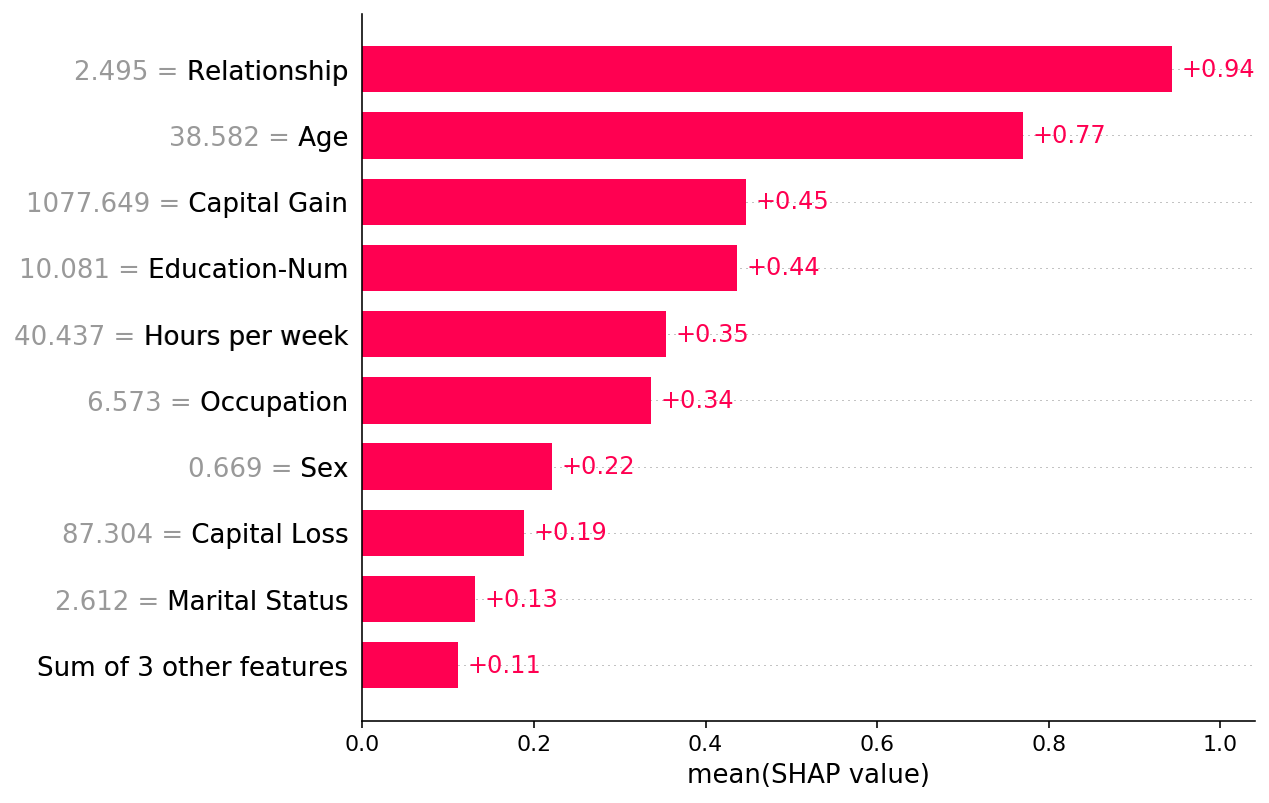
But the mean absolute value is not the only way to create a global measure of feature importance, we can use any number of transforms. Here we show how using the max absolute value highights the Capital Gain and Capital Loss features, since they have infrewuent but high magnitude effects.
[61]:
shap.plots.bar(shap_values.abs.max(0))
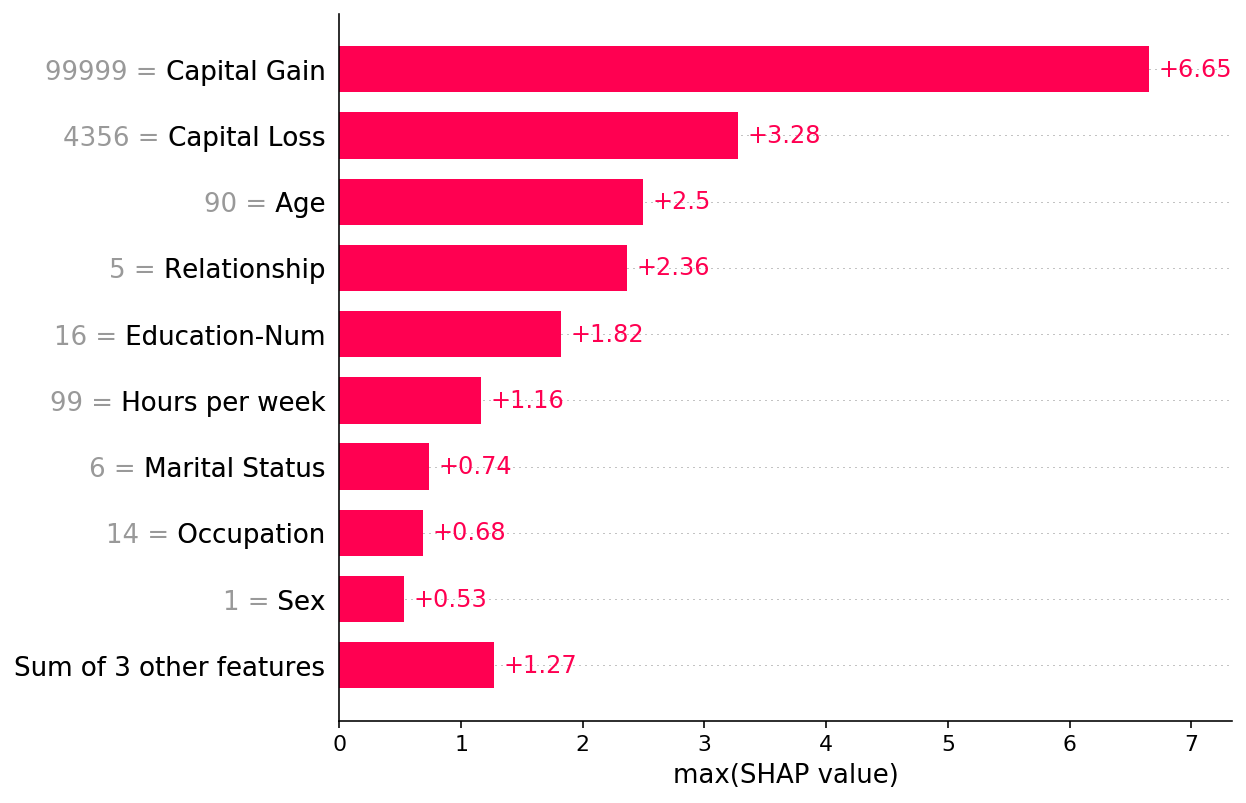
If we are willing to deal with a bit more complexity we can use a beeswarm plot to summarize the entire distribution of SHAP values for each feature.
[62]:
shap.plots.beeswarm(shap_values)
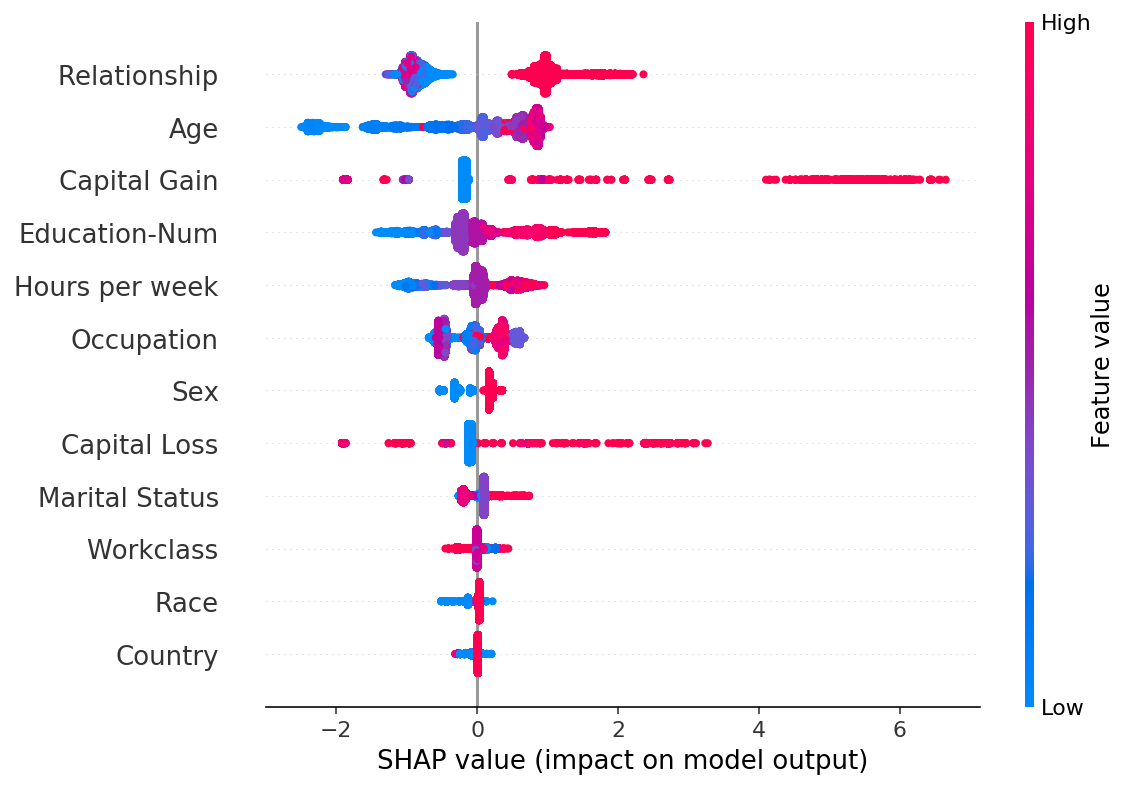
By taking the absolute value and using a solid color we get a compromise between the complexity of the bar plot and the full beeswarm plot. Note that the bar plots above are just summary statistics from the values shown in the beeswarm plots below.
[63]:
shap.plots.beeswarm(shap_values.abs, color="shap_red")
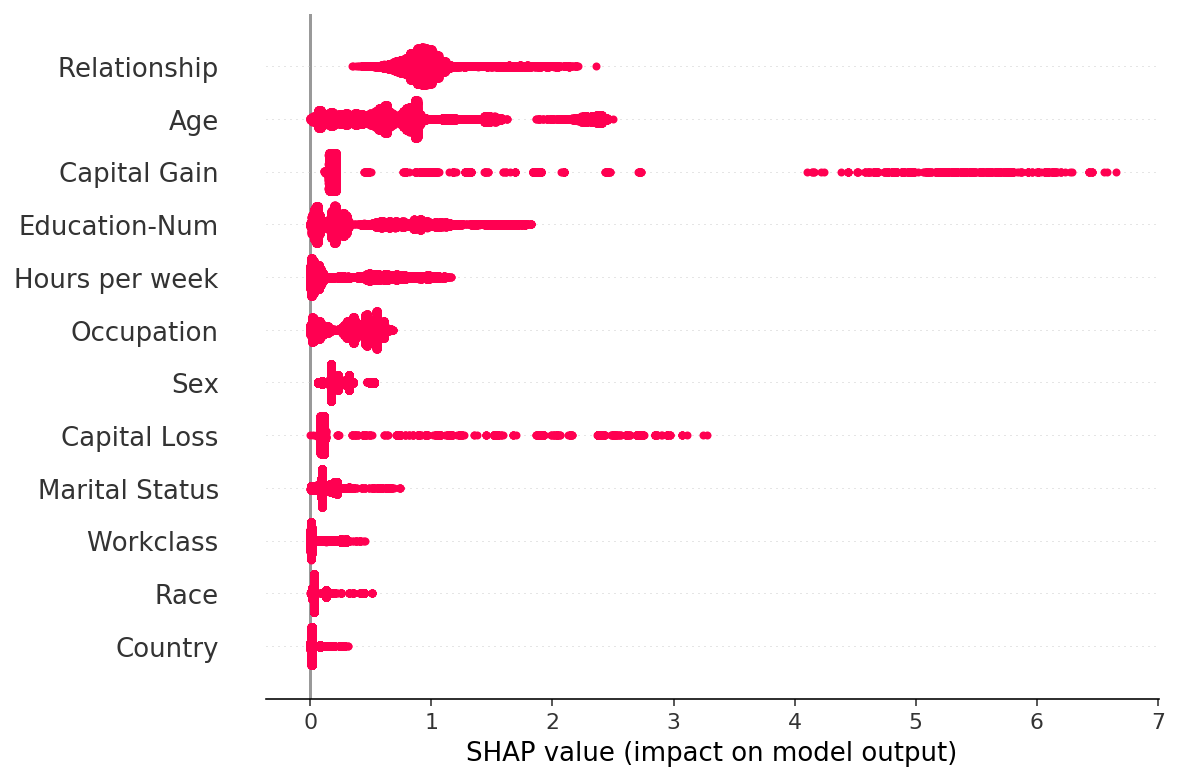
[65]:
shap.plots.heatmap(shap_values[:1000])
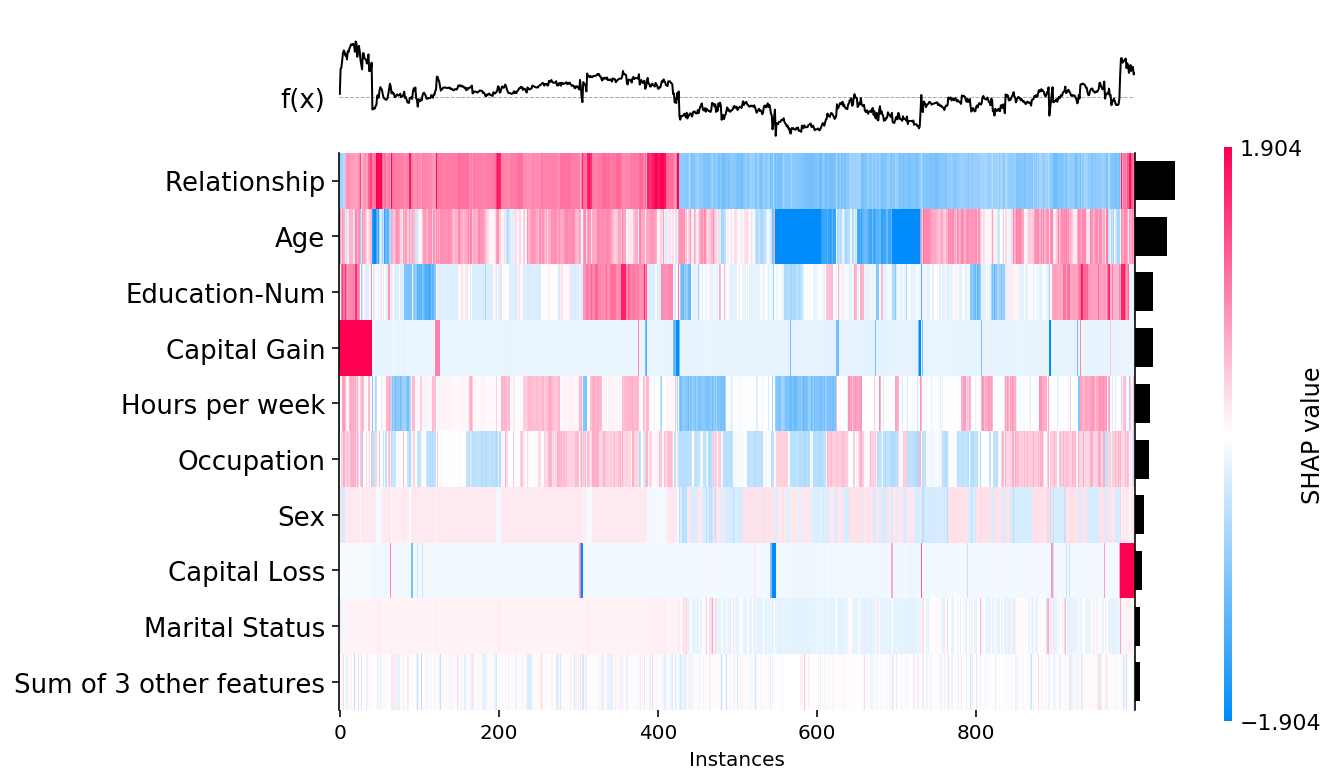
[66]:
shap.plots.scatter(shap_values[:,"Age"])
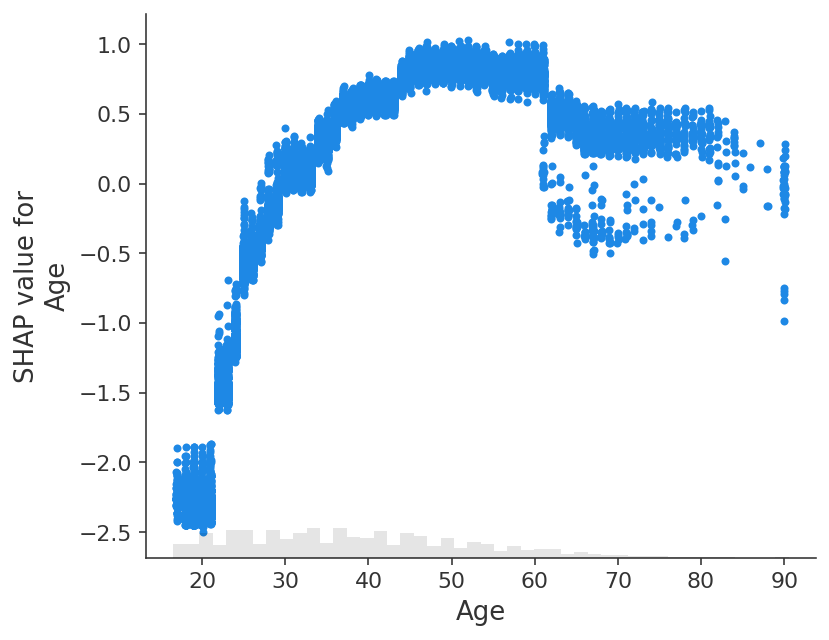
[67]:
shap.plots.scatter(shap_values[:,"Age"], color=shap_values)
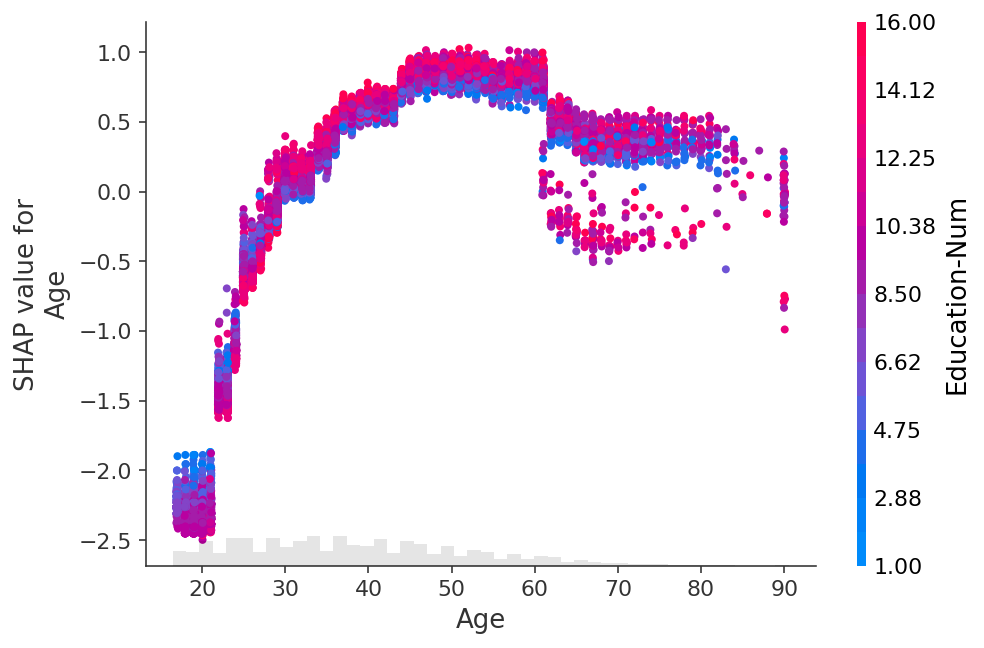
[69]:
shap.plots.scatter(shap_values[:,"Age"], color=shap_values[:,"Capital Gain"])
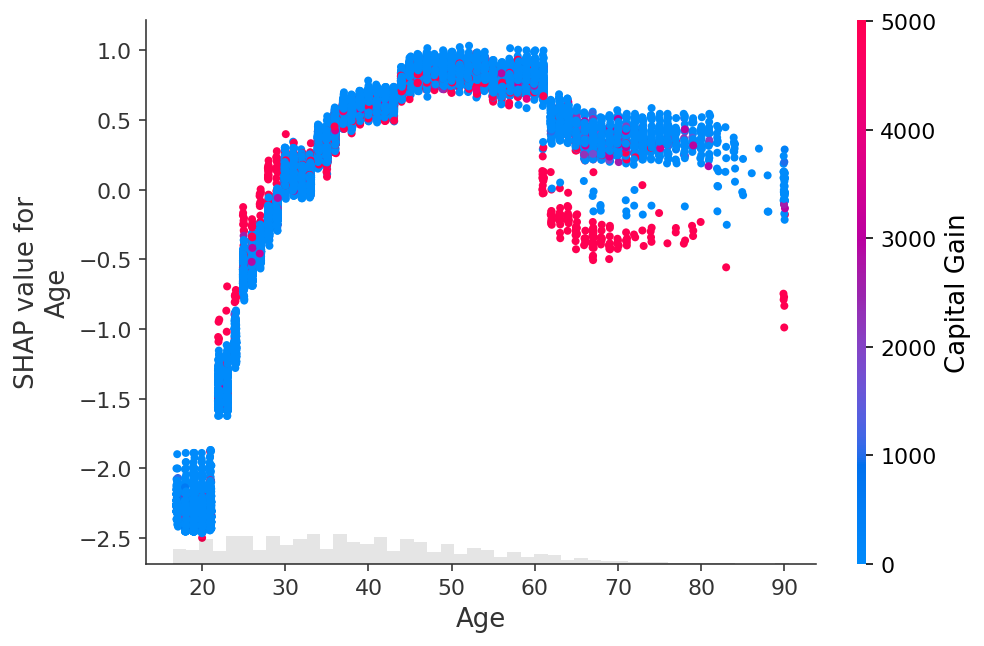
[75]:
shap.plots.scatter(shap_values[:,"Relationship"], color=shap_values)
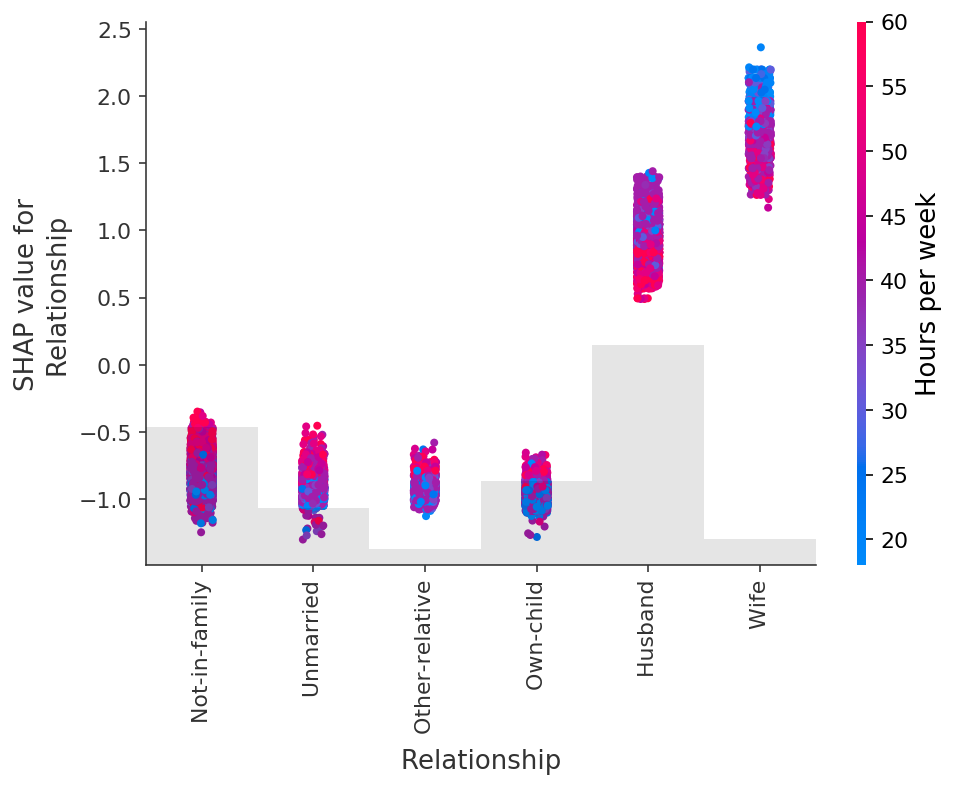
Explaining a transformers NLP model¶
This demonstrates how SHAP can be effectively applied to complex model types with highly structured inputs.
[87]:
import transformers
import nlp
import torch
import numpy as np
import scipy as sp
# load a BERT sentiment analysis model
tokenizer = transformers.DistilBertTokenizerFast.from_pretrained("distilbert-base-uncased")
model = transformers.DistilBertForSequenceClassification.from_pretrained(
"distilbert-base-uncased-finetuned-sst-2-english"
).cuda()
# define a prediction function
def f(x):
tv = torch.tensor([tokenizer.encode(v, pad_to_max_length=True, max_length=500) for v in x]).cuda()
outputs = model(tv)[0].detach().cpu().numpy()
scores = (np.exp(outputs).T / np.exp(outputs).sum(-1)).T
val = sp.special.logit(scores[:,1]) # use one vs rest logit units
return val
# build an explainer using a token masker
explainer = shap.Explainer(f, tokenizer)
# explain the model's predictions on IMDB reviews
imdb_train = nlp.load_dataset("imdb")["train"]
shap_values = explainer(imdb_train[:10])
explainers.Partition is still in an alpha state, so use with caution...
[88]:
# plot the first sentence's explanation
shap.plots.text(shap_values[:3])
0th instance:
1st instance:
2nd instance:
[90]:
shap.plots.bar(shap_values.abs.mean(0))
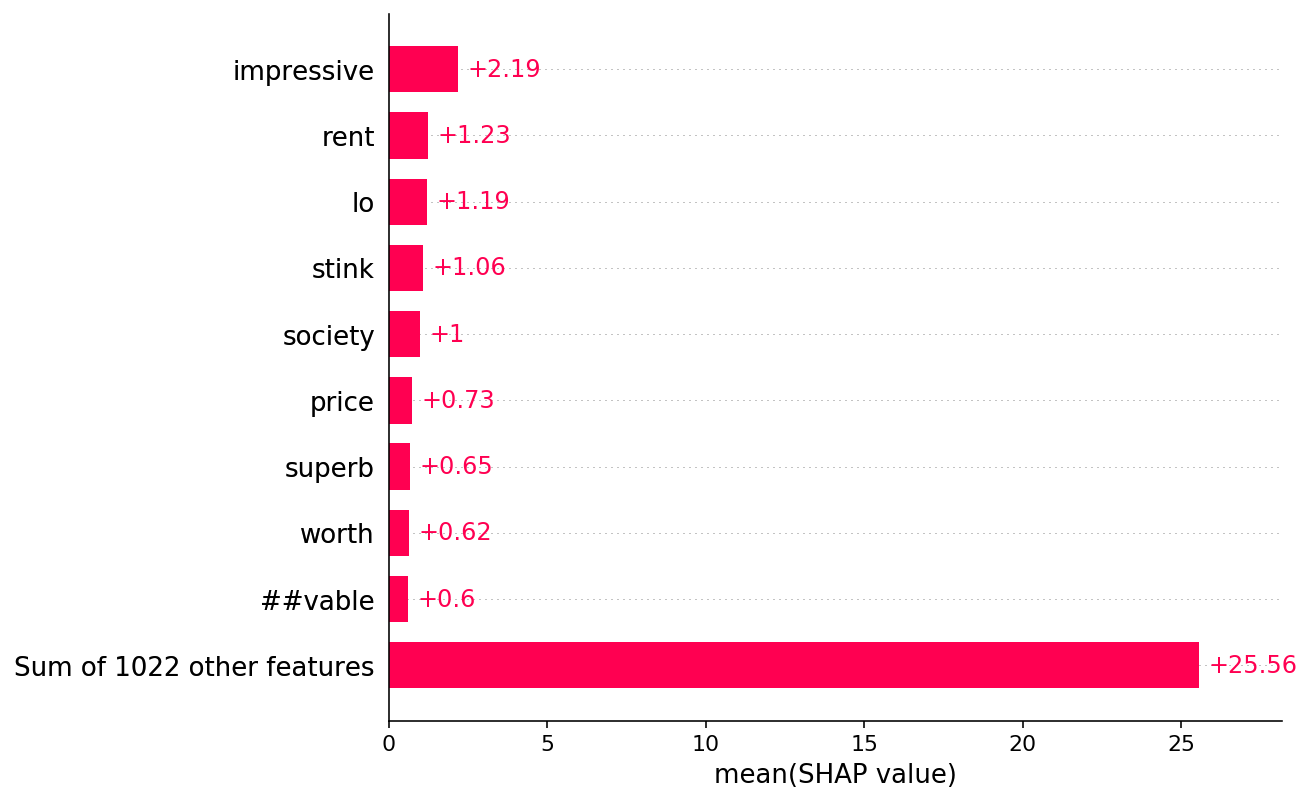
[91]:
shap.plots.bar(shap_values.abs.sum(0))
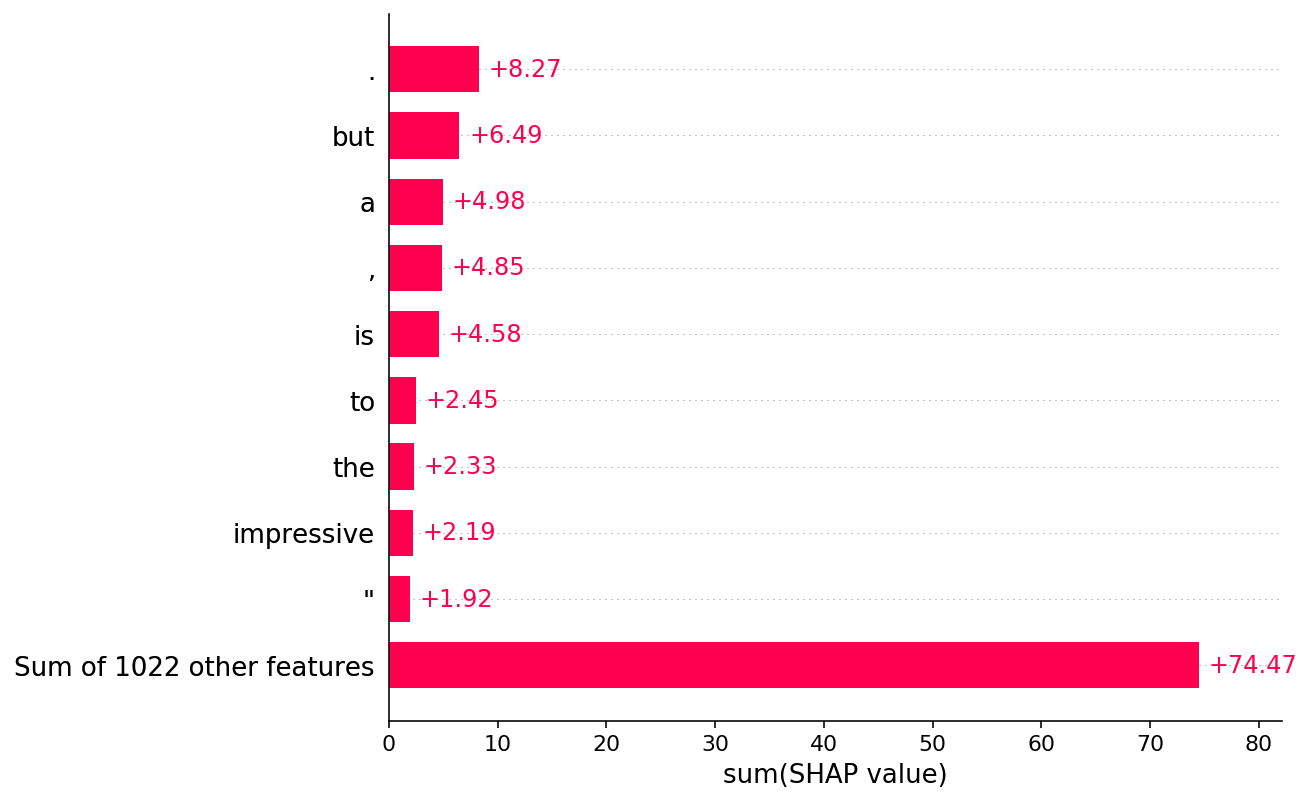
[ ]:
